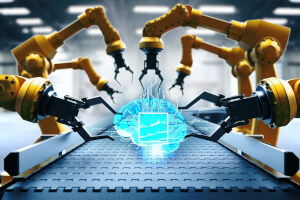The Impact of Robotics Integration in Manufacturing Industries on Employment

The Integration of Robotics into Manufacturing Industries and Its Employment Impact
The integration of robotics into manufacturing industries has sparked extensive debate about its impact on employment. While automation can lead to job displacement in certain sectors, it also creates new opportunities and transforms existing roles. Here's an industry-specific analysis:
Automotive Manufacturing
The automotive industry has been at the forefront of adopting robotics. Hyundai's $7.6 billion EV Metaplant in Georgia employs 475 robotic arms and 300 Autonomous Guided Vehicles, aiming to produce 500,000 vehicles annually. While the plant supports over 1,300 jobs and plans to increase to 8,500, concerns about reduced human labor persist.
Conversely, Amazon's robotics facilities in Massachusetts showcase a collaborative approach, where robots like Hercules and Proteus work alongside humans, enhancing productivity without significant job losses.
Electronics and High-Tech Manufacturing
In electronics manufacturing, robots handle tasks like assembling printed circuit boards with high precision. While this reduces manual labor, it increases demand for skilled workers to program and maintain these robots.
Retail and Warehousing
Retail giants like Walmart have invested heavily in automation, leading to a workforce reduction of nearly 70,000 employees over five years, despite revenue growth. Automation in fulfillment centers has streamlined operations, but wage growth hasn't kept pace with sales increases.
Amazon's approach differs, emphasizing human-robot collaboration. Their facilities employ over 16,000 people alongside 750,000 mobile robots, focusing on enhancing productivity and safety.
Construction
Construction has been slower to adopt robotics due to the complexity of tasks. However, robots are now used for tasks like excavation, rebar tying, and drywall installation, reducing physical strain on workers. While some jobs may be displaced, new roles in robot operation and maintenance are emerging.
Agriculture
Agricultural robotics, such as autonomous tractors and harvesters, address labor shortages and increase efficiency. While they may reduce the need for manual labor, they create opportunities in robot maintenance and data analysis.
Textile and Apparel
Automation in textiles has led to job losses in traditional roles. However, it has also created demand for skilled workers in areas like machine programming and maintenance. The shift requires workforce reskilling to adapt to new technologies.
Food and Beverage
Robots in food manufacturing handle tasks like packaging and quality control, improving efficiency and safety. While some manual jobs are reduced, new roles in overseeing and maintaining automated systems are created.
Mining and Heavy Industry
Automation in mining enhances safety by handling hazardous tasks. While it reduces the need for manual labor, it increases demand for skilled technicians to manage and repair automated systems.
Conclusion
Robotics in manufacturing presents both challenges and opportunities. While certain jobs are displaced, new roles emerge, requiring a shift in workforce skills. The net impact on employment depends on industry-specific factors and the ability to adapt through education and training.


